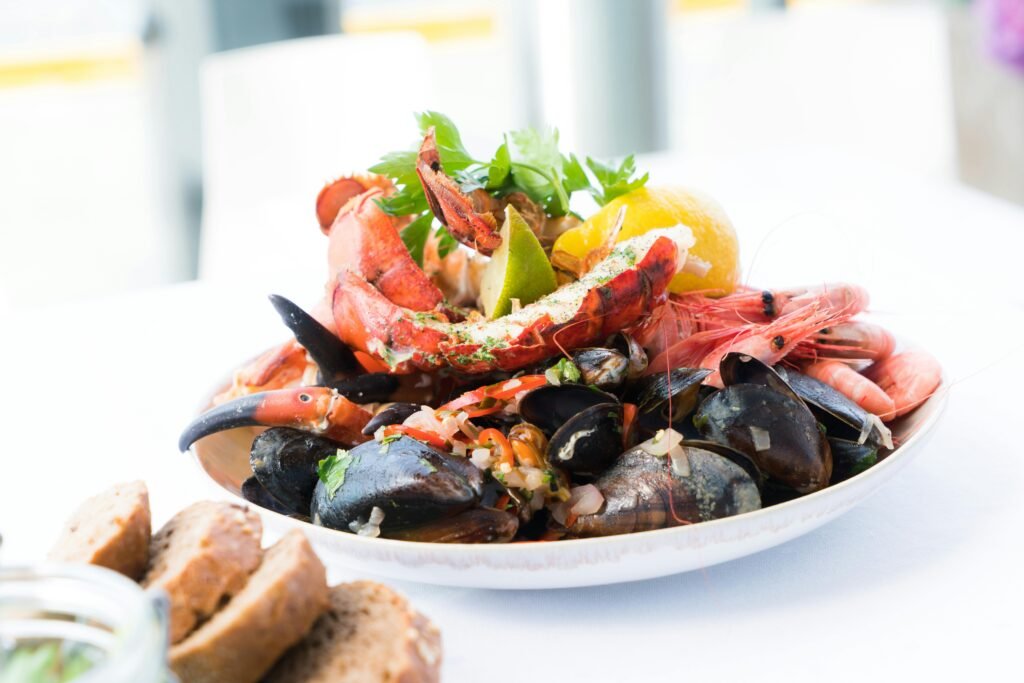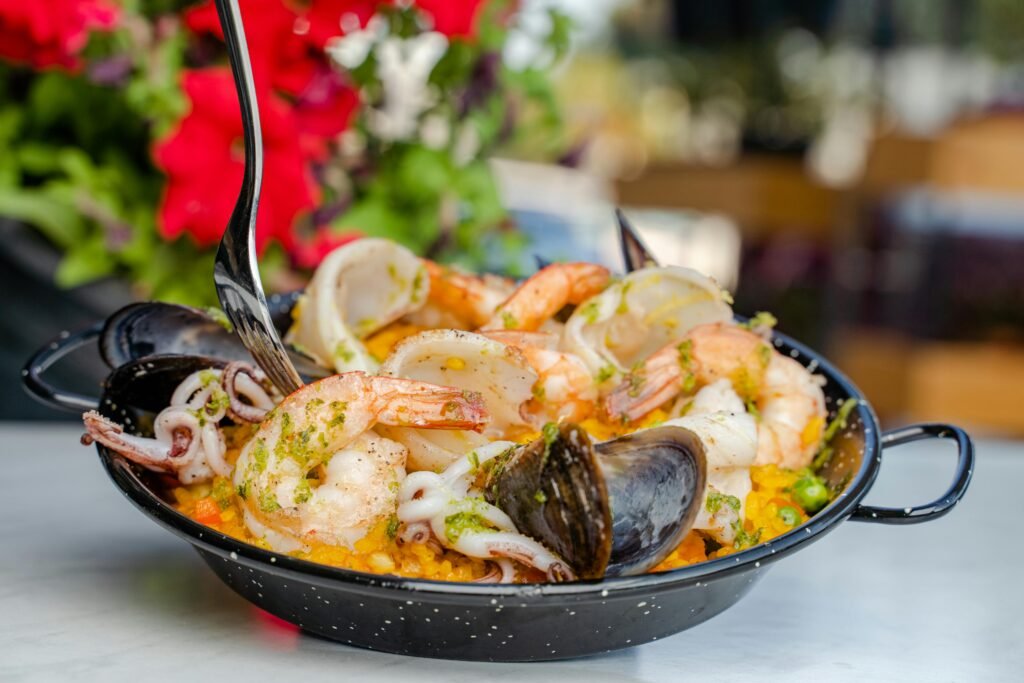Introduction to Spanish Cuisine
Spanish cuisine is a vibrant tapestry woven from a rich history, diverse regional ingredients, and unique cultural influences. Over centuries, Spain has absorbed flavors and cooking techniques from various civilizations, including the Romans, Moors, and Celts, each contributing to the country’s distinctive culinary landscape. This fusion of traditions has resulted in a plethora of regional dishes, making Spain a top destination for food lovers seeking an authentic gastronomic experience.

Each region of Spain boasts its own culinary identity, showcasing local ingredients and distinct cooking methods that reflect the area’s geography and history. For instance, the Mediterranean coast is renowned for its seafood, characterized by dishes such as paella and anchovies, while the interior regions like Castilla-La Mancha are famous for hearty stews and game meats. The Basque Country, known for its innovative cuisine, utilizes fresh produce and a variety of fish, resulting in a unique flavor profile. In the south, Andalusia offers a wealth of tapas and influences from North Africa, highlighting an extensive use of spices and garlic.
Local ingredients play a crucial role in shaping Spanish cuisine. Fresh vegetables, olive oil, herbs, and spices are essential components that enhance the flavors of traditional dishes. Additionally, the importance of seasonal and regional produce is emphasized in how locals approach cooking, ensuring that every meal reflects the best what the land has to offer at that moment. This focus on locality not only heightens the taste experience but also underlines a commitment to sustainability and community.
It is this blend of history, regionality, and local sourcing that makes Spanish cuisine so diverse and appealing. As one explores the varied culinary offerings, it becomes evident why Spain is celebrated among food enthusiasts and why its dishes are valued well beyond the borders of the country.
Andalusia: The Heart of Spanish Flavors
Andalusia, located in the southern part of Spain, is renowned for its vibrant culinary scene that embodies the essence of Spanish gastronomy. One of the most iconic dishes from this region is gazpacho, a refreshing cold soup made primarily from ripe tomatoes, cucumbers, bell peppers, and garlic, blended together with olive oil and vinegar. This dish exemplifies the Andalusian love for fresh, local produce and is a staple during the hot summer months.
Another celebrated dish is salmorejo, a thicker variation of gazpacho that also features tomatoes but is enriched with bread to create a creamy texture. Often topped with hard-boiled eggs and jamón ibérico, salmorejo serves as a perfect representation of Andalusian flavors. Jamón ibérico, on the other hand, is a prestigious cured ham produced in the region, known for its rich taste and melt-in-the-mouth texture. It is typically served in thin slices and offers a unique gastronomic experience to those who indulge in its luxurious flavor.
Fried fish, especially pescaito frito, is another quintessential Andalusian specialty. This dish features a variety of small fish, lightly battered and fried to perfection, often accompanied by a wedge of lemon. It is commonly enjoyed along the coast and reflects the region’s proximity to the Atlantic Ocean. The emphasis on fresh, locally sourced ingredients extends to all aspects of Andalusian cooking, showcasing the commitment of local chefs to quality and sustainability.
Traditional cooking techniques in Andalusia often involve slow cooking, grilling, or frying, one of the oldest methods that imparts distinct flavors and textures to the dishes. The harmonious blend of different culinary influences, seasonal ingredients, and time-honored practices makes Andalusia a focal point in Spanish cuisine, truly highlighting its status as the heart of Spanish flavors.
Catalonia: A Symphony of Tastes
Catalonia, a region in northeastern Spain, is renowned for its vibrant culture and rich culinary heritage. This area boasts a diverse array of flavors, heavily influenced by its coastal location along the Mediterranean Sea. Catalonia’s cuisine is characterized by fresh, high-quality ingredients that reflect both the land and the sea. One of the most emblematic dishes is pa amb tomàquet, which translates to “bread with tomato.” This simple yet flavorful dish consists of rustic bread topped with ripe tomatoes, drizzled with olive oil, and seasoned with salt. It is often enjoyed as a tapa or alongside charcuterie, highlighting the region’s love for fresh produce and bold flavors.
Another dish that stands out is escalivada, which features grilled vegetables such as eggplant, peppers, onions, and tomatoes. This dish not only encapsulates the essence of Catalan cooking but also showcases the region’s agricultural bounty. Served warm or at room temperature, escalivada can be enjoyed as a side or as a main course, often accompanied by anchovies or served on toast. The grilling process enhances the natural sweetness of the vegetables, providing a smoky and savory profile that resonates with locals and visitors alike.
Catalonia is also famous for its desserts, with crema catalana being one of the most beloved. This custard dessert, similar to crème brûlée, features a creamy base flavored with cinnamon and lemon zest, topped with a crispy caramelized sugar crust. The contrast between the smooth custard and the crunchy topping creates a delightful experience that perfectly concludes any meal. The region’s abundant seafood, such as fresh fish and shellfish, further enriches its culinary landscape, leading to dishes like suquet de peix, a traditional fish stew that celebrates the flavors of the Mediterranean.
Basque Country: Pintxos and Tradition
The Basque Country is renowned not just for its breathtaking landscapes but also for its rich culinary heritage, which plays a vital role in Spanish gastronomy. At the heart of Basque cuisine lies the concept of pintxos, small snacks that are often enjoyed in the vibrant bars that populate towns like San Sebastián and Bilbao. Traditionally, pintxos are composed of a variety of ingredients, skewered with a toothpick, providing a perfect opportunity to sample a diverse array of flavors in a single outing. These delightful bites are typically served on a piece of bread, ranging from the classic chistorra (a type of sausage) to inventive combinations that showcase local produce and seafood.
In addition to pintxos, the Basque Country boasts iconic dishes that reflect its maritime heritage and agricultural bounty. One standout dish is bacalao a la vizcaína, salted cod prepared in a rich Vizcayan sauce made from red peppers, tomatoes, and onions. This dish epitomizes the robust flavors characteristic of Basque cooking and serves as an excellent representation of the region’s culinary prowess. The emphasis on fresh, high-quality ingredients is evident, as local chefs strive to highlight the natural flavors while employing traditional cooking techniques.
The influence of the Basque culinary movement on modern gastronomy cannot be overstated. This movement has garnered international acclaim, with several Basque chefs going on to earn Michelin stars, helping to shape contemporary dining experiences worldwide. The focus on innovation, respecting culinary traditions, and personal expression in cooking has led to a renewed appreciation for local ingredients. Dining in the Basque Country, therefore, is not just about savoring individual dishes; it is an immersive encounter with a rich culinary landscape that encapsulates traditions while also embracing modernity.
Galicia: Seafood Heaven
Galicia, a picturesque region situated in the northwest of Spain, is renowned for its exceptional seafood, making it a culinary paradise for food enthusiasts. The region’s lengthy coastline and rich maritime culture have greatly influenced its gastronomy, resulting in an abundance of fresh fish and shellfish that grace local tables. The proximity to the Atlantic Ocean not only provides access to a diverse range of seafood but also contributes to the distinct flavors associated with Galician cuisine.

A hallmark dish of Galicia is pulpo a la gallega, or Galician-style octopus. This dish showcases octopus that is boiled to perfection until tender, then sliced and served on a wooden platter, dusted with paprika, sea salt, and a generous drizzle of olive oil. The simplicity of the preparation allows the natural flavors of the octopus to shine through, reflecting the region’s emphasis on quality ingredients. Additionally, the succulent and savory notes of this dish make it a must-try for visitors seeking authentic flavors.
Another culinary treasure of Galicia is the empanada gallega, a savory pie filled with a myriad of ingredients, including tuna, spicy chorizo, and even vegetables. This dish is often enjoyed during picnics or gatherings, embodying the Galician spirit of sharing and community. The flaky crust and rich fillings highlight the region’s agricultural products, further connecting the land’s bounty with its seaside heritage.
For those with a sweet tooth, tarta de Santiago offers a delightful ending to any meal. This traditional almond cake, often adorned with a symbol of the cross, is a staple in Galician dessert offerings. Its dense yet moist texture, combined with a hint of citrus, reflects the region’s penchant for quality local ingredients and artisanal craftsmanship.
In summary, Galicia’s maritime culture deeply informs its culinary practices, particularly in the context of seafood. The region’s unique dishes, such as pulpo a la gallega, empanada gallega, and tarta de Santiago embody the essence of Galician life, drawing visitors into a rich tapestry of flavors and traditions that are celebrated throughout this vibrant region.
Valencia: Home of Paella
Valencia, a vibrant city on the eastern coast of Spain, is renowned worldwide for its iconic dish, paella. Originating from this region, paella symbolizes the rich culinary heritage of Valencia. This beloved dish, traditionally made with rice, saffron, and a variety of ingredients, can be found in numerous variations, including seafood paella, vegetarian paella, and the classic Valencian paella. Seafood paella often features local catches such as prawns and mussels, while the vegetarian version highlights the region’s lush produce. The traditional Valencian paella includes rabbit, chicken, and sometimes snails, showcasing the agricultural abundance of the area.

The significance of rice cultivation in Valencia cannot be overstated. The Albufera Natural Park, located just south of the city, is home to numerous rice fields, where the Japanese rice variety, “Bomba,” is predominantly grown. This particular rice is highly sought after for its unique ability to absorb flavors while maintaining its structure, making it ideal for paella. The cultivation process, deeply intertwined with local traditions, reflects the region’s history and commitment to quality food production.
Saffron, an essential ingredient in many traditional Spanish dishes, plays a crucial role in creating the distinct flavor and golden hue of paella. Grown in the nearby fields of La Mancha, this precious spice is harvested by hand during the early morning hours and has become a cornerstone of Valencian cuisine. Its value goes beyond culinary applications, as saffron is often associated with local festivals and celebrations. In addition to paella, visitors to Valencia can enjoy other local delicacies such as fideuà, a noodle dish similar to paella, but made with short pasta instead of rice. It is typically prepared in a similar manner and showcases the culinary versatility of the region.
Overall, Valencia stands out as the gastronomic epicenter of Spain, with its unique flavors and rich agricultural practices celebrated through its culinary creations. A trip to this city would be incomplete without indulging in a well-prepared paella, allowing visitors to fully appreciate the depth of the region’s flavor and tradition.
Madrid: A Melting Pot of Flavors
Madrid, the capital of Spain, is renowned for its vibrant and diverse culinary scene that reflects the historical influences of various cultures. This melting pot of flavors offers an array of dishes that appeal to both locals and visitors alike. One of the most iconic dishes worth savoring in Madrid is cocido madrileño, a traditional hearty stew that embodies the essence of Spanish comfort food. Typically made with chickpeas, assorted meats, and vegetables, cocido madrileño represents the culinary heritage of the city while showcasing the use of fresh, local ingredients. It is often enjoyed in the colder months, making it a comforting option for diners looking to experience authentic local cuisine.
In addition to cocido madrileño, another beloved treat found in the capital is the churros, which are often served with thick chocolate for dipping. These crispy, fried pastries have become synonymous with Spanish breakfast culture and are enjoyed by people of all ages. Whether enjoyed at a local café or as a late-night indulgence, churros with chocolate exemplify the sweet side of Madrid’s food offerings. Beyond these traditions, Madrid’s tapas culture also plays a significant role in its culinary landscape. Offering a wide variety of small plates, tapas allows diners to experience a range of flavors in one sitting. From patatas bravas to jamón ibérico, the selection is extensive and varies from one bar to another, each presenting its unique twist on classic dishes.
The city’s rich historical diversity has shaped its gastronomy, as influences from various regions in Spain and beyond converge in this culinary hub. This fusion creates an exciting atmosphere for food adventurers seeking to explore Madrid’s evolving palate. Therefore, whether you are partaking in a traditional meal or sampling exquisite tapas with friends, Madrid promises a culinary journey filled with unforgettable flavors and experiences.
Murcia: The Garden of Spain
Murcia, often referred to as “The Garden of Spain,” is celebrated for its rich culinary heritage that emphasizes fresh produce sourced from its fertile lands. The region boasts an abundance of fruits and vegetables, thanks to its favorable Mediterranean climate, making it an ideal location for farming. This agricultural bounty not only defines the local diet but also contributes significantly to the distinct flavors found in Murcian cuisine.
One of the standout dishes you must try is zarangollo, a traditional vegetable scramble made with zucchini and onions. This simple yet flavorful preparation exemplifies the farm-to-table philosophy that is central to Murcia’s culinary culture. The ingredients are often freshly harvested from local markets, ensuring that each bite bursts with flavor and authenticity. The blend of seasonal vegetables allows for variation throughout the year, showcasing the best of what Murcia has to offer in each season.

Another unique treat from this region is the famous paparajotes, a delightful dessert made from lemon leaves coated in a light batter and fried to golden perfection. This dish is not only a testament to the creativity in Murcian cooking but also a reflection of the area’s rich zest for flavor. The combination of the lemony aroma from the leaves and the light sweetness creates an irresistible treat that has become synonymous with Murcian gastronomy.
Incorporating these local ingredients into traditional recipes highlights the respect Murcians have for their agricultural roots. The region’s commitment to using fresh, high-quality produce fosters a culinary environment where dishes are not only delicious but also culturally significant. Experiencing the flavors that define Murcia is an essential part of exploring Spain’s diverse culinary landscape.
Final Thoughts: The Culinary Journey Through Spain
Spain is a country rich in culinary diversity, where each region showcases its own unique flavors, traditions, and ingredients. From the robust dishes of the north to the vibrant tapas culture of the south, every corner of Spain presents an opportunity to indulge in authentic gastronomic experiences. The culinary journey through Spain is not merely about eating; it is an exploration of history, culture, and community, where food is a vital part of the local identity.
In regions like Andalusia, travelers can savor the famous gazpacho and seafood dishes that highlight the Mediterranean influence, while the Basque Country offers pintxos that are a testament to their innovative approach to traditional ingredients. In Catalonia, the rich use of tomatoes and olive oil reflects a blend of flavors that have shaped its renowned cuisine. Similarly, the heart of Spain, Castilla-La Mancha, is known for its hearty stews and artisan cheeses that pay homage to its pastoral roots. Each region offers a distinct taste that invites exploration and appreciation of local products and culinary techniques.
For readers looking to immerse themselves in this culinary adventure, planning a trip to Spain centered around food can be incredibly rewarding. Consider timing your visit to coincide with local festivals that celebrate specific dishes, or seek culinary tours that provide insights into traditional cooking methods. Engage with local chefs who can share recipes passed down through generations. Don’t forget to visit the markets to experience firsthand the freshness of local produce, cheeses, and cured meats. Through these experiences, one not only enjoys the rich flavors of Spain but also gains a deeper understanding of its culture and people.











